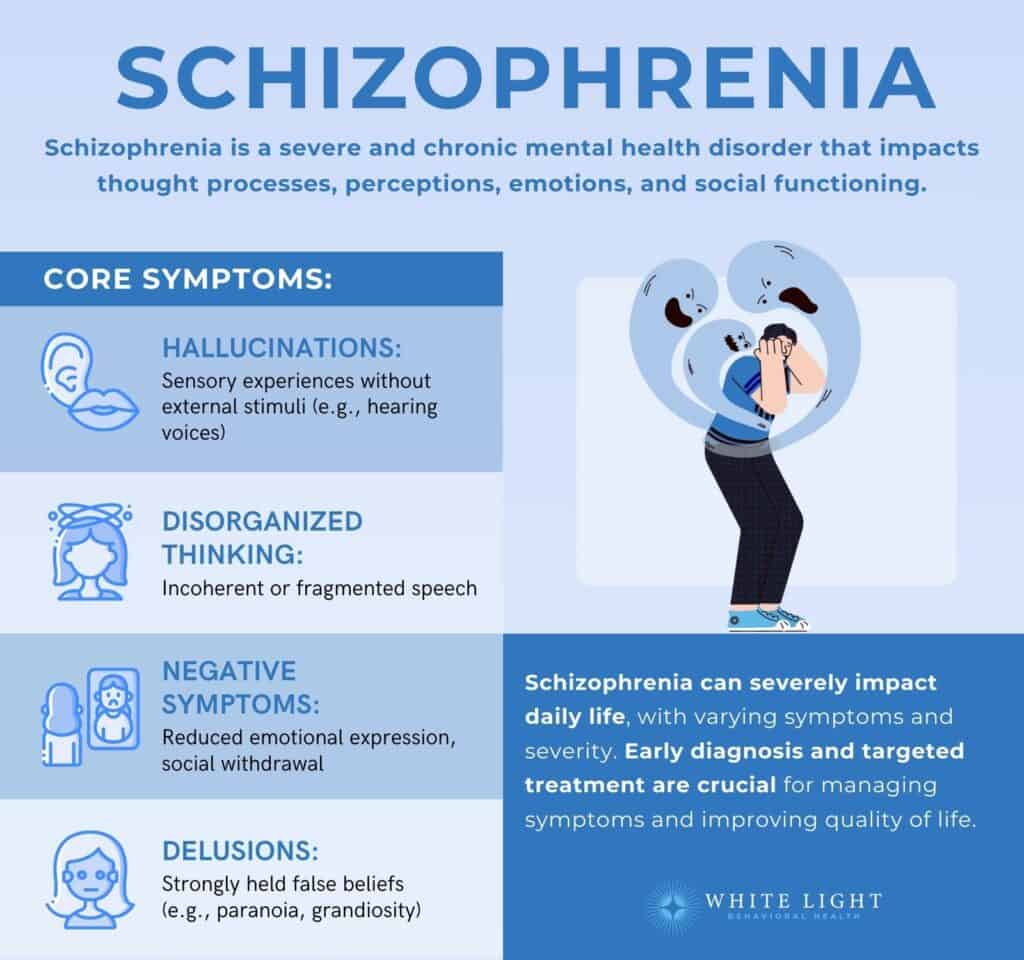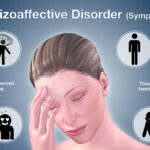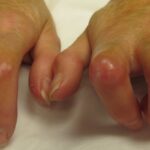Schizophrenia is a severe, chronic psychiatric disorder characterized by a profound disconnection from reality. It affects how individuals think, feel, and behave, often resulting in hallucinations, delusions, disorganized thinking, and significant social or occupational dysfunction. Schizophrenia typically emerges in late adolescence or early adulthood and, if left untreated, can severely impair quality of life.

Core Symptoms of Schizophrenia
Schizophrenia manifests through a complex constellation of symptoms classified into positive, negative, and cognitive categories.
Positive Symptoms (Psychotic Features)
- Hallucinations: Most commonly auditory, where individuals hear voices.
- Delusions: Firmly held false beliefs (e.g., persecution, grandeur, or control).
- Disorganized Speech: Incoherent thoughts expressed through jumbled or irrelevant speech.
- Disorganized or Catatonic Behavior: Unpredictable agitation or immobility.
Negative Symptoms (Deficits in Normal Function)
- Affective Flattening: Limited emotional expression.
- Avolition: Lack of motivation to initiate purposeful activities.
- Alogia: Diminished speech output.
- Anhedonia: Inability to feel pleasure.
Cognitive Symptoms
- Impaired Executive Functioning: Difficulty with planning and decision-making.
- Poor Working Memory: Challenges in retaining information for short periods.
- Attention Deficits: Trouble concentrating or filtering stimuli.
Types of Schizophrenia and Related Disorders
Though the DSM-5 has removed the subtypes, they are still useful for understanding clinical presentations:
- Paranoid Schizophrenia: Dominated by delusions and auditory hallucinations.
- Disorganized Schizophrenia: Marked by incoherent speech, inappropriate emotions, and chaotic behavior.
- Catatonic Schizophrenia: Characterized by motor immobility or excessive movement.
- Residual Schizophrenia: Presence of mild symptoms after acute episodes.
- Undifferentiated Schizophrenia: Mixed symptoms not fitting other categories.
Causes and Risk Factors
Schizophrenia arises from a complex interplay between genetic, neurobiological, and environmental factors:
Genetic Influences
- A strong hereditary component; first-degree relatives have a higher risk.
- Specific genetic mutations in dopamine and glutamate pathways contribute to vulnerability.
Brain Structure and Chemistry
- Enlarged ventricles, reduced gray matter, and hypofrontality observed in neuroimaging.
- Dopaminergic hyperactivity in certain brain regions linked to positive symptoms.
- Glutamate dysfunction also plays a role in cognitive and negative symptoms.
Environmental Triggers
- Prenatal complications: Malnutrition, infections, or stress during pregnancy.
- Early childhood trauma: Abuse, neglect, or early loss.
- Urban upbringing, migration, and substance use (notably cannabis and psychostimulants) increase risk.
Schizophrenia Diagnosis: Criteria and Clinical Process
Diagnosis is based on DSM-5 criteria and requires continuous signs of disturbance for at least six months, with at least one month of active-phase symptoms.
Evaluation Tools
- Structured clinical interviews: SCID or PANSS (Positive and Negative Syndrome Scale)
- Neuroimaging and lab tests: To exclude organic causes
- Psychological testing: To assess cognitive function
Differential Diagnosis: What to Rule Out
| Condition | Key Differences |
|---|---|
| Schizoaffective Disorder | Mood symptoms are prominent and sustained |
| Bipolar Disorder with Psychosis | Psychosis only during mood episodes |
| Major Depression with Psychosis | Delusions/hallucinations tied to depression |
| Drug-Induced Psychosis | Temporal association with substance use |
| Autism Spectrum Disorder | Onset in early childhood with social deficits |
Evidence-Based Treatment Approaches
Schizophrenia requires lifelong treatment with a combination of medication, psychotherapy, and psychosocial interventions.
Antipsychotic Medications
- First-Generation (Typical): Haloperidol, Fluphenazine
- Effective for positive symptoms; higher risk of extrapyramidal side effects.
- Second-Generation (Atypical): Risperidone, Olanzapine, Clozapine
- Broader symptom control; better for negative symptoms; metabolic side effects.
- Long-Acting Injectables (LAIs): Improve adherence in patients with poor medication compliance.
Psychotherapy and Psychosocial Interventions
- Cognitive Behavioral Therapy (CBT): Reduces psychotic symptom severity and improves insight.
- Family Therapy: Enhances support systems and reduces relapse rates.
- Social Skills Training: Promotes functional independence.
- Supported Employment and Housing: Addresses vocational and living needs.
Prognosis and Long-Term Management
The course of schizophrenia varies widely:
- 20% achieve substantial recovery
- 35% show moderate improvement with support
- Persistent disability occurs in others without effective intervention
Factors influencing outcome:
- Early intervention
- Adherence to treatment
- Strong social support
- Comorbid substance use negatively impacts prognosis
Coping Strategies and Living with Schizophrenia
Sustained management emphasizes:
- Routine and Structure: Regular sleep, meals, and daily activities
- Monitoring Relapse Signs: Early intervention can prevent full-blown episodes
- Avoiding Substance Use
- Engaging with Support Networks
- Empowerment and Psychoeducation
Research and Future Directions
Innovations are reshaping the landscape of schizophrenia treatment:
- Digital Therapeutics: Mobile apps and telepsychiatry for monitoring symptoms
- Cognitive Remediation Therapy (CRT): Targets cognitive deficits
- Neuroinflammation Studies: Exploring autoimmune contributions
- Precision Medicine: Tailoring treatment to genetic and neurobiological profiles
Schizophrenia is a chronic but manageable disorder when addressed with comprehensive care. Through medication, therapy, and consistent support, individuals can achieve meaningful recovery and reintegration into society. Advancements in neuroscience and psychiatry continue to offer hope for more personalized, effective interventions.

